Why do people collect cameras with no intention of using them? Okay, maybe that’s a little unfair. Some collectors do enjoy using their vintage cameras. But for most collectors, buying classic and antique cameras is more about the joy of owning and admiring something special and different, while researching and learning about its place in the history of photography.
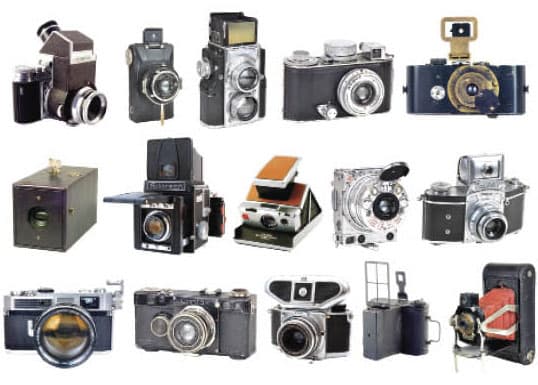
There are a lot of old cameras around, many of which are of no intrinsic value or deserving of a special place either in photographic history, or on a camera collector’s shelves. So how do you tell what is collectable? Sometimes it’s a matter of age, other times it’s the manufacturer or perhaps the country of origin.
It could be a camera’s rarity, an unusual specification or method of working, a one-off, a landmark in design… Finally sometimes it’s just a gut feeling, nothing more than the fact that you like the look of a particular camera and buy it in the way you might purchase any work of art. If you have never thought about buying a camera as a collector’s item, or even if you are a collector already and are seeking confirmation of your sanity, read on.
Collectability factors
Some key considerations to think about before taking the plunge and waving your debit card around…
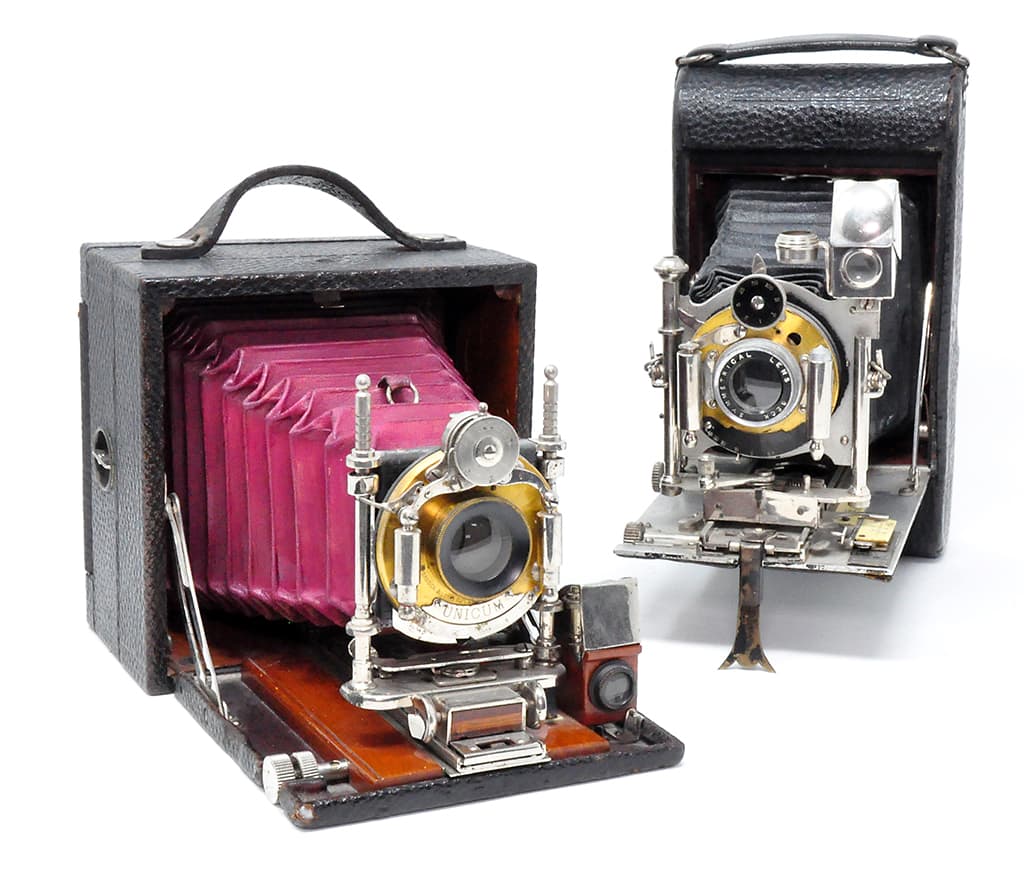
Early plate and film cameras c.1903: No.3 Eastman Plate Camera (left) and Butcher Carbine for roll film
Age
The older the camera, the more its way of working is likely to be of interest. Although what has come to be recognised as the first photograph was taken in 1826, the first practical method of photography came with the daguerreotype process in 1839 and the cameras that used it.
Cameras from this era are very collectable – and equally expensive. As are those from the following wet plate period. For the collector on a more realistic budget, collecting usually starts with dry plate cameras from the late 19th century until the 1950s, or 35mm and roll film cameras from around 1900 until the dawn of the digital age.

Just four of the vast range of different types of camera made by Zeiss Ikon, left to right: Ikoflex III roll film TLR, Contarex 35mm SLR, Kolibri 127 film camera and Super Ikonta 120 film folding camera
Manufacturer
While most collectors go for a wide and often eclectic mix of cameras, some concentrate wholly on one manufacturer. Leitz is a favourite, with its Leica cameras, along with the huge range of lenses and accessories, all confined to the 35mm format. Zeiss Ikon is another preference.
The company was formed in 1926 by amalgamating four other companies that go back much further and who, between them, made a vast range of different camera types, many of which continued to be made by Zeiss. Other names that attract single-minded collectors include Rollei, Canon, Ensign, Nikon, Voigtländer, Kodak and more.
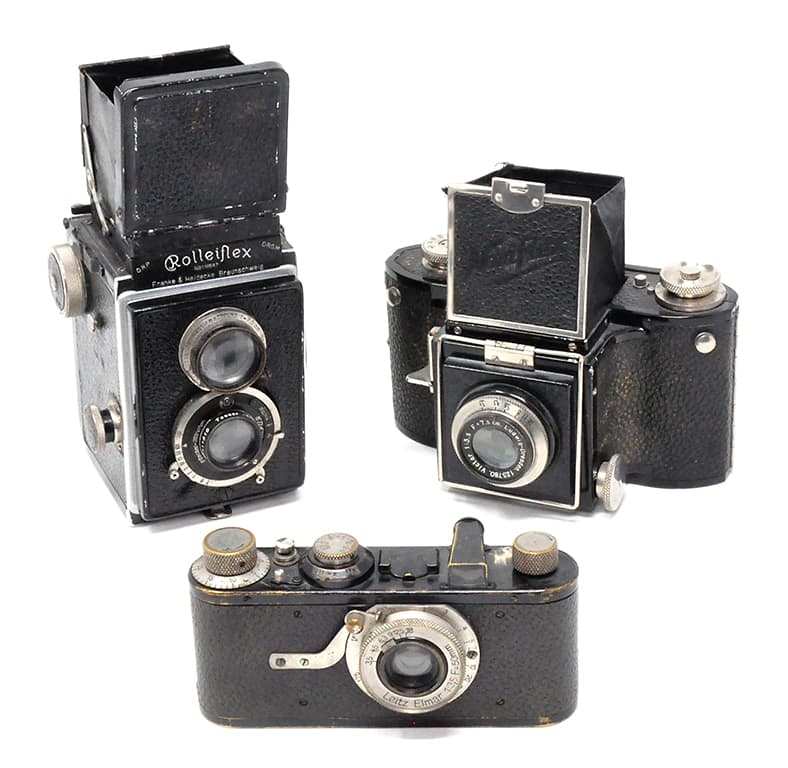
Three notable firsts: Leica I, first viable 35mm camera; original Rolleiflex, first compact roll film TLR; and Noviflex, first 6x6cm roll film SLR
Landmarks
Whatever make or type of camera, there was always a first: the first Leica/Rolleiflex/Canon/Minolta/Olympus/Nikon, the first SLR, the first twin lens reflex, the first SLR with an eye-level viewfinder, the first camera with through-the-lens metering, the first SLR with an instant return mirror, the first instant camera, the first 35mm/16mm/120/127 film cameras… all these factors and more make certain cameras landmarks. And if it’s a landmark, it’s worth acquiring.

The rare Maton camera
Rarity
Some cameras were only ever made in limited numbers. Others failed to stand the test of time with few still existing. Very occasionally only one version of a particular camera was made. Whatever the reason, such cameras are rare and rarity is collectable.
Collectors might not like to admit it, but they do enjoy obtaining a camera that no one else owns or, better still, has never before seen. The French Maton is a perfect example. Inside, an angled mirror reflected the image from the lens through 90 degrees and down onto paper-backed film running along the base of the body.
With the addition of a suitable light source, it also acted as a projector. It was made in 1930 and few have survived.

The unusual PDQ that delivered a print within minutes of exposure
Unusual specifications
A classic camera is a pretty simple concept. A lens on the front that projects its image onto film or a glass plate at the back, a means of controlling focus and exposure, plus a shutter. The majority followed the traditional design.
A few didn’t, and that’s what makes them collectable. Here, for example, is the American PDQ camera from 1935. It shot pictures on rolls of direct-positive print paper. Turning a handle on the side released the paper and placed it behind the lens.
After exposure, the photographer pulled a knob which activated a cutter to slice through the exposed paper, dropping it into a one-shot developing solution contained in a tank below.

Two Alfa cameras, unexpectedly made in Poland
Country of origin
Which countries made the best-known cameras? England in the early years, Germany of course and then Japan. Anyone else? Yes, quite a lot actually. France was once prolific in camera manufacture, as was Russia.
But what about the more obscure camera-making countries? In 1948 Hungary made the Duflex, the first SLR with an instant return mirror; in 1955 Italy made the strange-looking Summa Report with four lenses, two for shooting, two for viewfinding; in 1960 Poland made the unusually styled Alfa.
Seek out the weird and wonderful from unexpected countries and you have another reason to collect.

Colourful cameras, left to right: Kodak No.2 Hawkette, Mickey Mouse Petie camera, Kodak Rainbow Hawkeye, Coronet Midget and Ensign Ful-Vue
Colourful cameras
Not every camera was made in black. The 1930 Kodak No.2 Hawkette was made in brown Bakelite. Or there’s the Ensign Midget and No.2 Brownie, both made in silver in 1935 to celebrate the silver jubilee of King George V and Queen Mary.
Or how about the 1928 Vanity Kodak or the 1935 Coronet Midget, both of which were made in five colours. Or maybe the Ensign Ful-Vue which, in 1953, was made in what was planned to be red, white and blue to celebrate the Queen’s coronation, but which turned out to be red, grey and blue. If it’s colourful, it’s often collectable.
Do they still work? Make sure you don’t get sold a dud
That’s a question that collectors are continually asked. If you want to buy a collectable camera to use, here are six tips.
1) Go for cameras that take standard 35mm cassettes or 120 roll film, both of which are still available.
2) Check the shutter is working, especially at slow speeds which might stick on older cameras.
3) Check the lens for serious external surface scratches, or internal fungus.
4) If the camera uses bellows, make sure they are supple and there are no obvious light leaks.
5) Ensure that lens aperture and focusing rings turn smoothly. 6Avoid shooting against the light with early unbloomed lenses that can cause flare.
Prototypes
The first Wrayflex SLRs used a three-mirror system in place of a pentaprism, which had certain disadvantages. Before the company eventually added a pentaprism to the camera to become the Wrayflex II, they experimented with adding a fourth mirror to one of the early models.
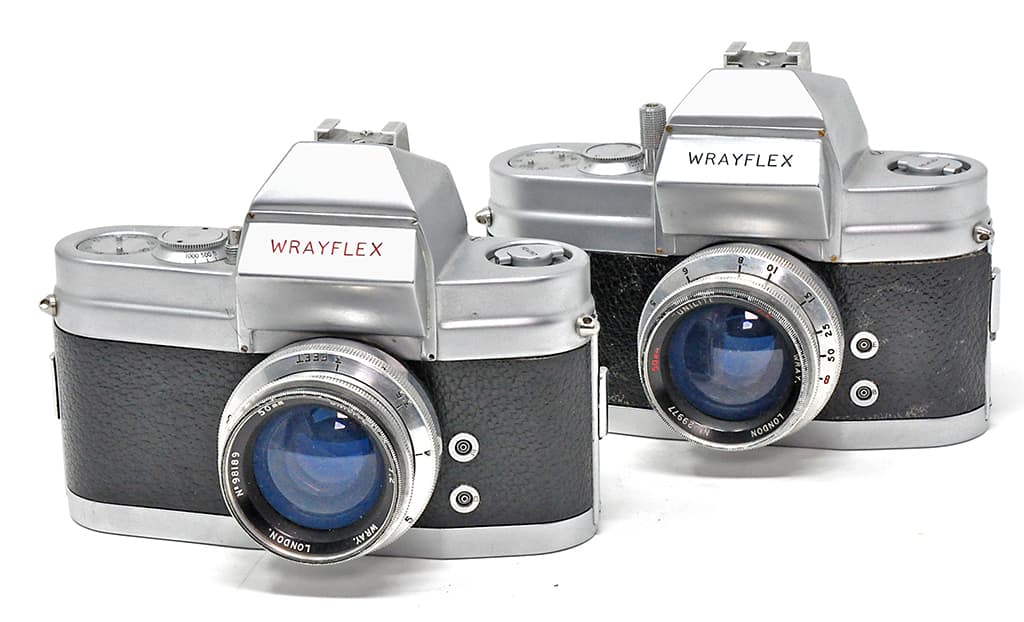
Two Wrayflex II prototypes – one more remains to be found
Hence these two prototypes came into being. The first was bought in the assumption that it was the only one in existence. Later on, the second one was discovered. Since the serial numbers of the two cameras are 3469 and 3471 it stands to reason that 3470 is out there somewhere. The search for the missing link is another aspect of what collecting is all about.
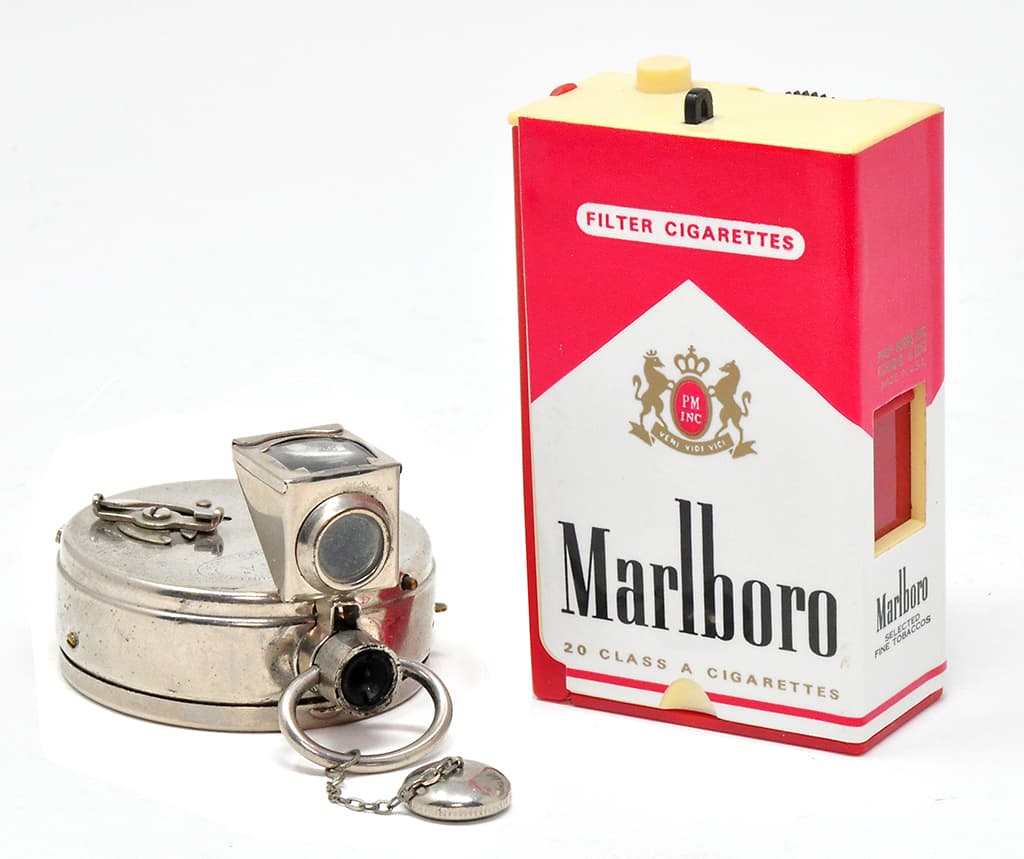
Disguised cameras from two eras: Ticka camera shaped like a watch from 1905 (left) and a Marlboro cigarette packet camera c.1989
Disguised cameras
During the history of photography, cameras have been disguised as all kinds of non-photographic objects that included books, cravats, walking sticks, waistcoat buttons, tie pins, parcels, belts, rings, lighters, matchboxes, cigarette packets, pocket watches, wristwatches, pens, hats, handbags, powder compacts, briefcases, binoculars, radios, revolvers and even machine guns.
Some were made for genuine espionage purposes, but most were made for photographers who wanted to shoot candid pictures without being noticed. It was a craze that came and went around the turn of the 20th century, but was resurrected with the advent of 110 film in 1972. The early cameras are more collectable than those from the later wave.
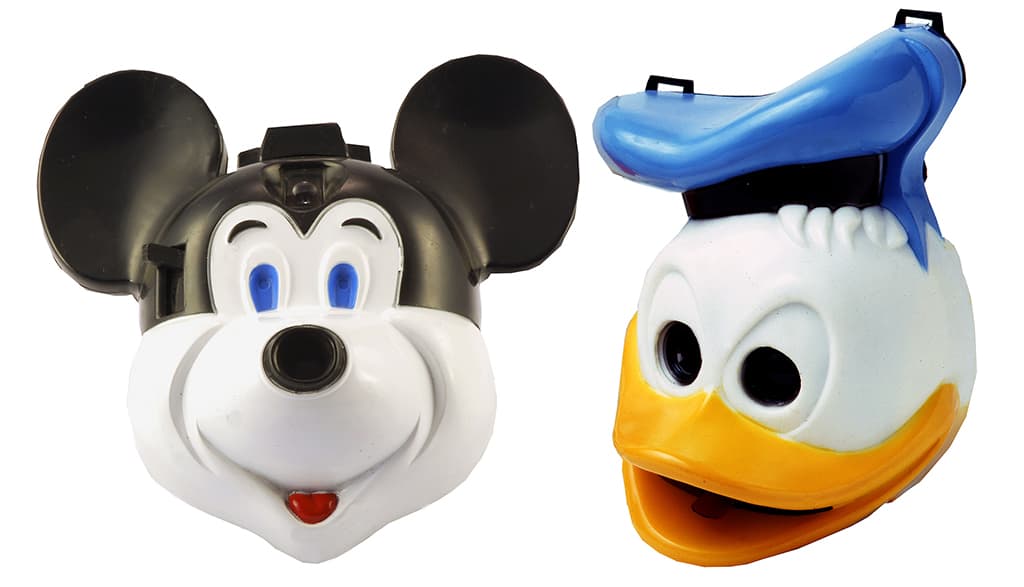
Toys turned into cameras: the Mick-a-Matic for 126 Instamatic film and Donald Duck Camera that took 127 film
Toy cameras
Normal cameras made as toys are generally not collectable. Cameras that are contained within a more conventional toy or cartoon character are. The most obvious examples are Mickey Mouse-shaped cameras and, less common, Donald Duck.
Others include Charlie the Tuna, Snoopy the Peanuts dog, various clowns, panda bears and even Father Christmas. Such cameras might be shunned by serious collectors, but they are still a lot of fun.

Early digital: the Canon iON with its image recording discs, which worked more like a still video camera
Early digital
The past few years have seen an awakening interest in collecting digital cameras from the early years. Digital cameras became available to the public in the late 1980s and, in many ways they echoed the early years of film camera development in that various manufacturers tried different ways of achieving a similar end.
The Canon iON (standing for Image Online Network) from 1988, for example, was the first digital camera aimed at consumers. It wasn’t a digital camera as we know it today, though, but more like a still video camera that recorded images on a revolving disc. Those factors make it collectable.
Collecting for investment
Prices right now are stable and rising slowly. Leica and Rollei have always commanded high prices, which have slowly risen over the years. English Wrayflex cameras have recently increased in value threefold. Wood and brass is very popular with American buyers.
Chinese buyers on eBay are paying top prices for most quality cameras, which keep the prices buoyant overall. Anything unusual or rare commands a good price. All of that said, it should be emphasised that camera collecting is really about owning small pieces of photographic history and learning something of the fantastic, often weird, ways in which cameras were once manufactured.
For most collectors, it’s not about making money. So how much should you pay for a collectable camera? Ask Jim McKeown, the renowned American collector who publishes McKeown’s Price Guide to Antique and Classic Cameras, a veritable bible for camera collectors. It was Jim who coined an epithet that has become known as McKeown’s Law.
It states this: The price of an antique camera is entirely dependent upon the moods of the buyer and seller at the time of the transaction. Wise words that every single camera collector, buyer and seller should keep close to their hearts.
Collectable camera types
More practical advice to help budding collection builders

Sanderson’s Universal Swing Front Camera, one of the first from this maker
Wood and brass
Craftsmanship is always collectable, as epitomised by this Sanderson Universal Swing Front Camera from 1895. It’s typical of the designs of the late 19th and early 20th centuries, in which a lens panel was separated from a plate holder back by bellows, the whole thing supported on a baseboard. So-called field cameras that followed the basic design were many and various. Frederick Sanderson, who built this particular model, was a cabinet maker.
The then revolutionary rise and fall, swing and tilt movements of which the camera was capable were designed to satisfy his needs as a keen architectural photographer.

Early 35mm SLRs: the second model of the Kine Exakta (rear) and the now rare Russian Sport
35mm SLRs
The Kine Exakta, made in 1936, was the first 35mm SLR which makes it a collectable landmark. But rarer, more unusual in style and, for many, more collectable is the Sport which came from Russia in 1937. It was a little like a Leica with a large box to house the reflex viewfinder on the top, which had to be held to the eye at right angles to the film plane, giving a laterally reversed image.
For some time it was thought that this was the first 35mm SLR, until research in Russia became easier and it was discovered that its launch date was later than thought.
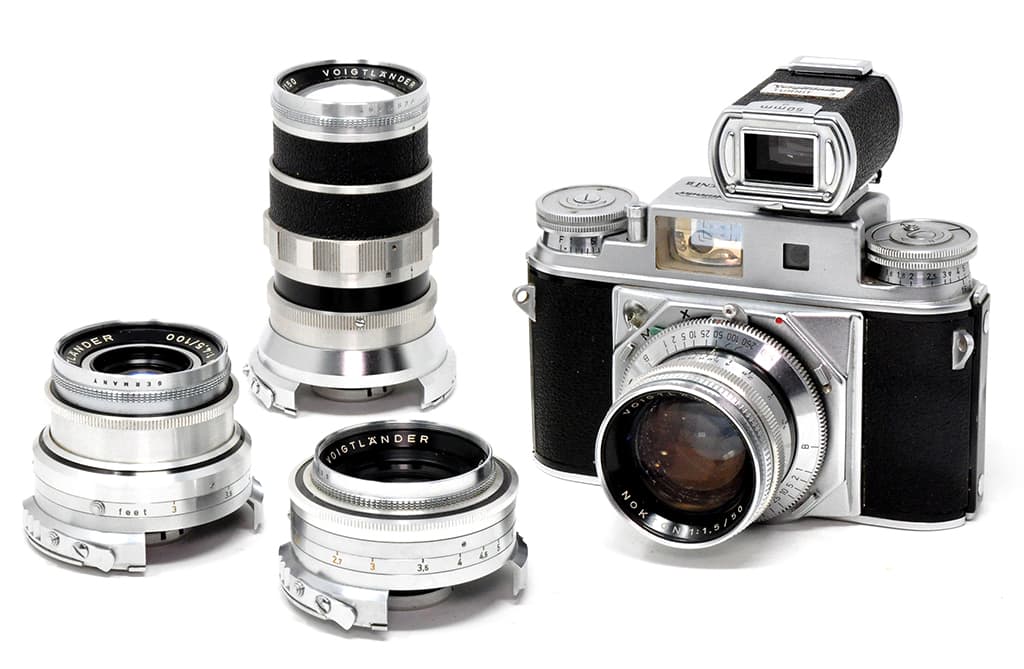
Voigtländer Prominent 2 with special Turnit 3 viewfinder fitted alongside wideangle, medium tele and telephoto lenses
35mm rangefinder cameras
The first truly viable 35mm camera was the Leica I, launched in 1925. In the years that followed, 35mm became the most popular film format, especially for coupled rangefinder cameras. This Voigtländer Prominent 2 from 1958 is particularly collectable.
It’s an upgrade of an earlier model from 1950, standing at the centre of a system that includes a vast range of quality lenses from wideangle to telephoto, copying and close-up devices, filters, viewfinders and even a mirror box that turns the camera into an SLR.
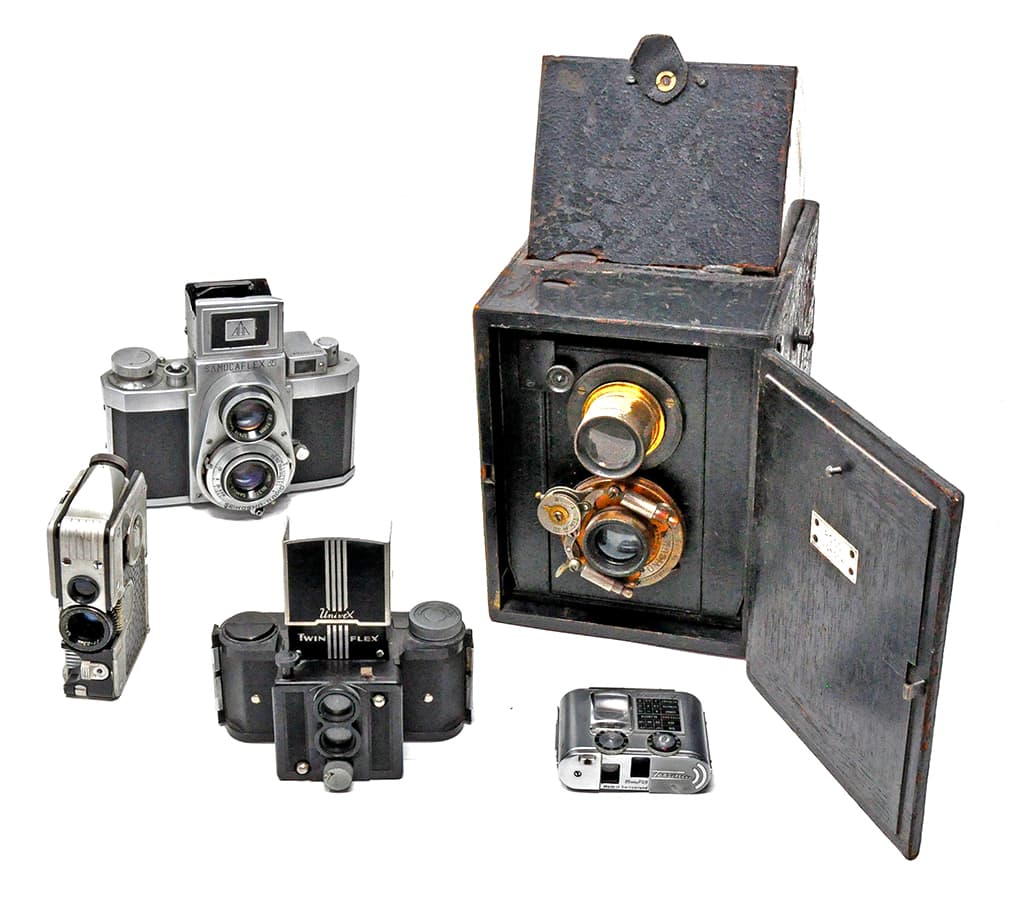
Not every TLR looked like a Rolleiflex. Left to right: Minicord, Samocaflex, Univex Twin Flex, Tessina and Ross Portable Divided Camera
Twin lens reflexes
The Rolleiflex, with its use of 120 roll film and a style of having two lenses – one for shooting, the other to reflect its image up to a hooded screen on the top of the body – epitomises what most people think of as a twin lens reflex (TLR).
Rolleiflexes are still very usable and hugely collectable. But there were many different styles of TLR, some dating back to the glass plate days, others designed for different formats that took 127 film, a few for 35mm film and even some that accepted 16mm and subminiature film. The more unusual TLR variations appeal to many collectors.
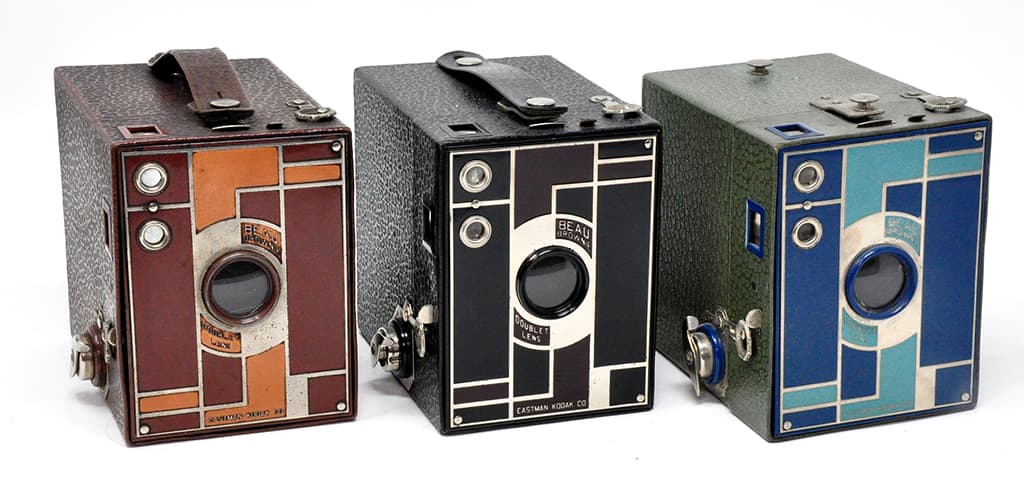
Three colours of the Art Deco style Beau Brownie
Roll film cameras
So many cameras have taken so many different sizes of roll film over the years that it’s impossible to single out one that is more collectable than any other. So here’s one of the most basic – the humble box camera, but an unusual and collectable variety.
The Beau Brownie, which was made in 1930, was available in two sizes for 120 and 116 film and with five different coloured Art Deco face plates. They comprised black/maroon, dark brown/tan, dark blue/light blue, turquoise/green and rose/pink, each with a matching leatherette covered body.

Two swing lens panoramic cameras: Kodak Panoram No.1 (left) and Al-vista
Panoramic cameras
The first successful panoramic camera was made in 1844. Although panoramic photography was achieved by several methods, the most popular was the use of a swing lens, as seen in cameras like the Kodak Panoram models starting from 1900.
The lens of each was contained at the end of a short cylinder with a slit at the opposite end. As the shutter was released, the lens swung from side to side, gradually building up a super-wide image on film arranged in a curved plane.
Panorams used roll film and were available in sizes that produced images ranging from 58x180mm to 90x305mm. Other panoramic cameras were made for 35mm and even 16mm film.
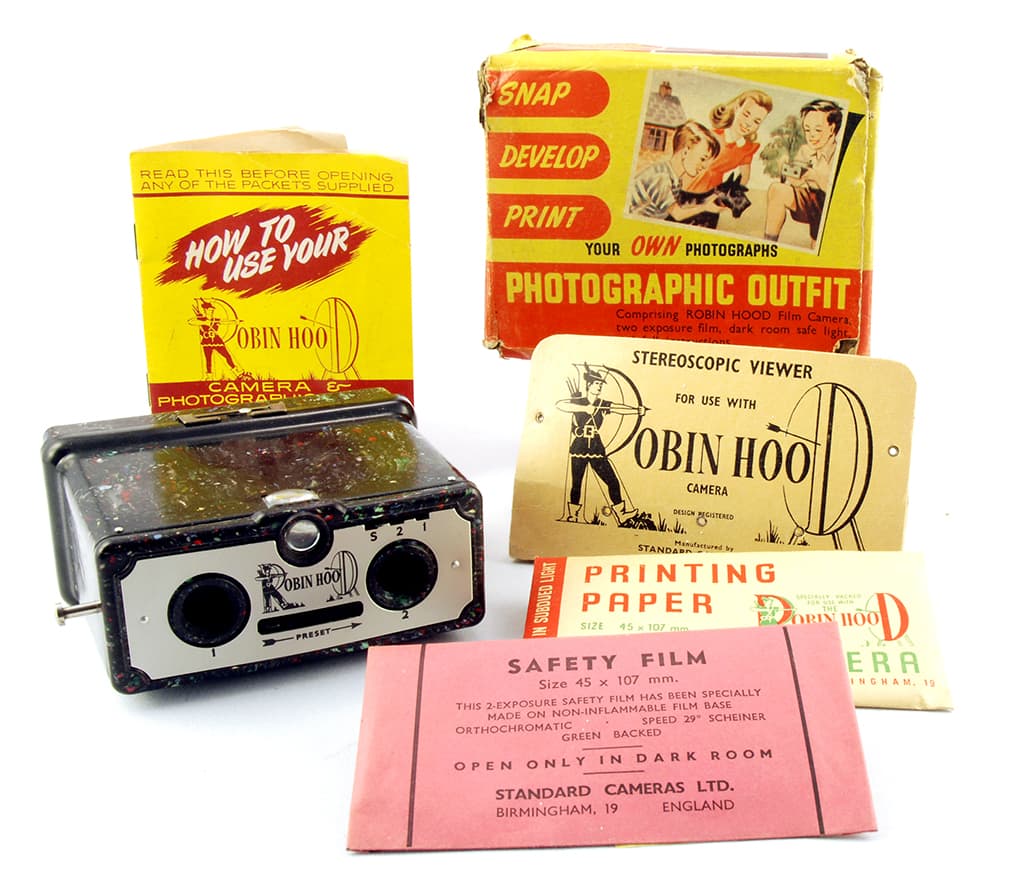
The Robin Hood stereo camera with its box, instructions, stereo viewer, film and paper packs
Stereo cameras
A stereo camera takes twin pictures which, when viewed in a suitable viewer, combine to display a single three-dimensional image. Stereo cameras have been around since the earliest days of photography, but were particularly popular in the 1930s and 1950s. This Robin Hood camera from 1930, made in multi-coloured marbleised Bakelite, is one of the simplest.
It took single sheets of film, 45x107mm, pre-loaded in a darkroom, and which could then be developed using the camera back as a developing tray. The Robin Hood is particularly collectable if found in its original box with instructions, viewer, film and paper packs.
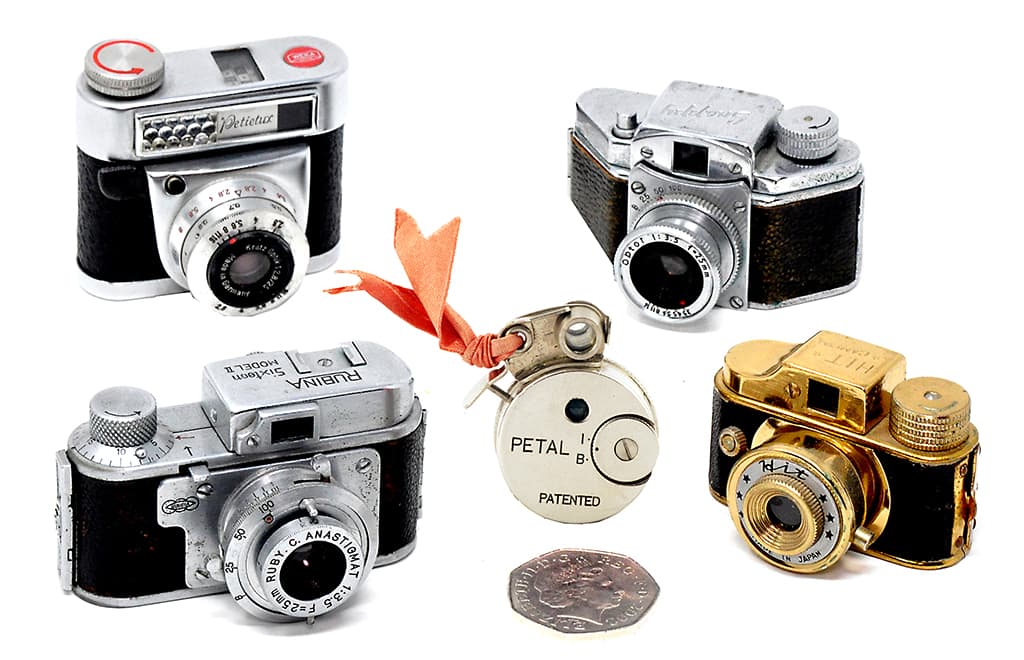
The 50p coin in the foreground gives an indication of the size of the Petal (centre) surrounded by subminiature Petietux, Rubina, Snappy and Hit cameras
Subminiature cameras
Back in the 1920s, 35mm was known as a miniature format, but once it became established as a workable alternative to larger roll film sizes, 16mm cine film, used in still cameras, became the new miniature format. Some went even smaller.
Made in 1948, the Japanese Petal, at 3cm diameter, is recognised by collectors as the smallest production camera ever made. Circular-shaped film in a metal container was dropped into the back of the camera and exposed six circular pictures, each one just 5mm in diameter.
Club class
If you’re interested in camera collecting, or if you are already a collector and would like to meet others, join the club. It’s called the Photographic Collectors’ Club of Great Britain. Find out more here
Further reading
Box clever: how to use Box Brownies
The most curious cameras ever
Roll-film SLRs: beautiful and affordable







